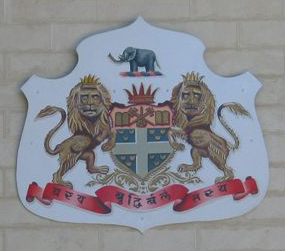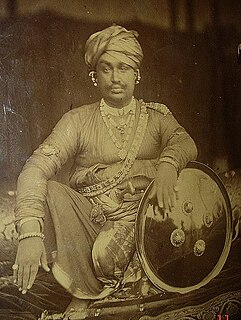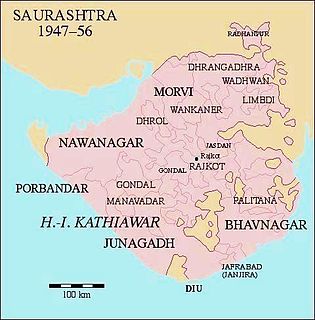
Maharaja Raol Sir Takhtsinhji JaswantsinhjiKIH, was Maharaja of Bhavnagar, a Rajput chief of the Gohil clan, and ruler of Bhavnagar state in Kathiawar. He succeeded to the throne of Bhavnagar upon the death of his father, Jaswantsinhji, in 1870.

The Rajkumar College in Rajkot, Gujarat is one of the oldest K-12 institutions in India. RKC has a 26-acre campus in Rajkot.
Ramgarh Raj was a major Zamindari estate in the era of the British Raj, in the former Indian province of Bihar. The estate was ruled by Narain Dynasty. Territories which comprised the Ramgarh Raj presently constitute districts of Ramgarh, Hazaribagh, Chatra, Giridih, Koderma, and Bokaro with 3672 villages. The entire area is rich in minerals like coal and mica and falls under the Indian State of Jharkhand. The First King was Maharaja Baghdeo Singh and the last ruling king was Maharaja Kamakhya Narain Singh of this estate, until the estate was merged to the Republic of India. The revenue of the estate was about 3600000 and the ruling family was the first family in India to use helicopters in election campaigns.

Patan is a town in the Indian state of Rajasthan. In the 12th century, it became the centre of a minor state called Tanwarawati or Torawati, ruled by a Tomar family. Anangpall II, who established the city of Patan and ruled present day Delhi. Anangpall II, is considered to be a direct descendant of Raja Parikshit, Son of Abhimanyu and Grandson of Arjuna. (Pandavas)

Bhagvatsinhji was the ruling Maharaja of the princely state of Gondal from 1869 till his death in 1944, upon which he was honoured with 11-gun salute. He was the only Maharaja to take a medical degree and other degrees.

Maharajadhiraj Mirza Maharao Sir Khengarji III Sawai Bahadur was a progressive and one of the longest ruling monarchs of the world and also the longest ruling king of the Princely State of Cutch from 1875 to 1942.

Maharajadhiraj Mirza Maharao Sri Sir Vijayarajaji Khengarji Sawai Bahadur, GBE was the ruling Rao of Cutch from 1942 to his death in 1948.
Maharaja Sir Umed Singh II was a ruling Maharaja of Kotah from 1889 to 1940. The great-great-great-great-great-grandson of Kishore Singh, a Raja of Kota, Sir Umed Singhji was adopted at a young age by Shatru Sal II the then Maharaja of the state. Following his death in 1889, Umed Singhji embarked on a long and distinguished career as a soldier and statesman, being educated at Mayo College in Ajmer.

Colonel Maharaja Raol Sir Shri Krishna Kumarsinhji Bhavsinhji KCSI was an Indian monarch and politician, the last Maharaja of the Gohil dynasty, who ruled Bhavnagar State from 1919 to 1948 and also served as the first Indian Governor of Madras from 1948 to 1952,After handover Rule of Bhavnagar State to Sardar Vallabhbhai Patel as part of Indian Union, and Bhavnagar is first state which joined Indian Union.

Kutch State was a state within India from 1947 to 1956. Its capital was Bhuj.
Maharajadhiraj Mirza Maharao Sri Madansinhji Vijayaraji Sawai Bahadur was the last official ruler of Princely State of Cutch from 26 February 1948 to 1 June 1948.

Maharajadhiraj Mirza Maharao Shri Deshalji II Sahib Bahadur was the Rao of Cutch belonging to Jadeja dynasty, who ascended the throne of Princely State of Cutch upon deposition of his father Bharmalji II by British. He reigned during his minority, under a Council of Regency, headed by Captain MacMurdo and composed of Jadeja chiefs.

Palitana was a princely state in India during the British Raj until 1948. The center was the city of Palitana. The last ruler of the state received a privy purse of 180,000 Rupees at the state's accession to independent India on 15 February 1948.
Sindhis in India are a socio-ethnic group of people originating from Sindh, a province of modern-day Pakistan. After the 1947 partitioning of British India into India and Pakistan, a million Sindhi Hindus migrated to India. As per the 2011 census of India, there are 2,772,364 Sindhi speakers in India.

Maharao Pragmulji III of Kutch is present titular head of Jadeja dynasty of the former Kutch State.
Himmatsinhji M. K. was a noted ornithologist, politician and scion of the erstwhile Jadeja ruling family of Kutch.
The line of succession to the former throne of Jodhpur, one of the pre-eminent Indian principalities, was by male primogeniture by the sons of Rajput mothers. Jodhpur State acceded to the Union of India in 1949.
The line of succession to the former throne of Rajpipla, one of the principal Indian salute states, was by male primogeniture. Ruled by the Gohil Rajput clan, the former Rajpipla State is now a constituent part of the Indian state of Gujarat.
The line of succession to the former throne of Idar, one of the principal Indian salute states, was by male primogeniture. Ruled by the Rathore Rajput clan, the former Idar State is now a constituent part of the Indian state of Gujarat.









